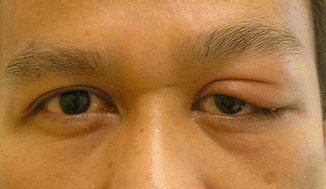Dacryoadenitis vs dacryocystitis- understanding eye conditions
When it comes to eye conditions, it’s essential to distinguish between various ailments to ensure accurate diagnosis and effective treatment. The differential diagnosis of closely related terminologies is mostly related to their anatomical condition. Being an eye physician, if we know the basic anatomy and pathology of the eye, we can smarlty diagnose the ocular conditions. The two conditions that may sound similar but are quite distinct are Dacryocystitis and Dacryoadenitis. In this article; dacryoadenitis vs dacryocystitis, we’ll delve into the differences between these two eye conditions.

Dacryoadenitis
Dacryoadenitis is the inflammation of lacrimal gland.
Causes
- Viral or bacterial infections
- Conditions like Sjögren’s syndrome, which affect the immune system
- Physical injury to the eye area can also cause inflammation in the lacrimal gland
Symptoms
- Swelling
- Tenderness in the upper outer portion of the eye
- Pain, especially when blinking
- Redness and watery eyes
- Blurred vision
- Sensitivity to light

Types
Acute dacryoadenitis
It is characterized by sudden and severe inflammation of the lacrimal gland. It often presents with noticeable symptoms, including:
- Pain and Tenderness: The area around the eye is painful and tender to the touch.
- Swelling and Redness: The eye area becomes visibly swollen and red.
- Watery Eyes
Causes
- Infection: Bacterial infections, often caused by Staphylococcus aureus, are the primary culprits.
- Obstruction: A blocked lacrimal gland duct can trap secretions and lead to inflammation
Chronic Dacryoadenitis
Chronic dacryoadenitis is a long-term and recurring inflammation of the lacrimal gland. It is usually less severe than the acute form, but it can lead to persistent discomfort
Symptoms
Patients may experience mild pain or discomfort around the eye. Swelling of the eye area can come and go over an extended period.
Treatment
Treatment focuses on addressing the underlying cause, whether it’s an infection or an autoimmune condition. Antibiotics, anti-inflammatory medications, and occasionally surgery may be required
Dacryocystitis
Dacryocystitis refers to the inflammation or infection of the nasolacrimal duct, which is the passageway connecting the eye’s lacrimal sac to the nasal cavity. This duct is responsible for draining tears away from the surface of the eye, ultimately helping to maintain a healthy and clear vision.
Causes
Dacryocystitis can occur due to the following causes
- Blockage of duct due to injury, tumors, congenital blockage, trauma
- Nasal infections due to bacteria
- Autoimmune diseases e.g. Sjögren’s syndrome
- Eye infections spreading to the tear drainange pathway i.e. nasolacrimal duct
Symptoms of dacryocystitis
The patient presents with
- Swelling of lacrimal sac
- Watering of eyes
- Tearing
- Redness
- Blurring of vision

Types
Congenital dacrycystitis– a common condition present in 2 to 4 months old infants due to decananlization of nasolacrimal duct.
Acute dacryocystitis– an acute condition in which the patient presents with pain in lacrimal sac along with tenderness and redness. The patient can also complain for watery, pus or mucos discharge.
Chronic dacryocystitis-Chronic dacryocystitis has all the symptoms except pain. Pain is the symptom of acute inflammation of nasolacrimal duct.
Treatment
The choice of treatment depends on the underlying cause and the severity of the condition. Treatment options may include
If an infection is the root cause of Dacryocystitis, antibiotics are typically prescribed. These medications help eliminate the infection and reduce inflammation
Warm compresses can provide relief by reducing swelling and promoting the natural drainage of the duct. This is often recommended alongside antibiotic treatment
In cases of persistent or severe Dacryocystitis, or when blockages are the primary issue, surgical procedures may be necessary. Two common surgical interventions are
Dacryocystorhinostomy (DCR)
DCR is a surgical procedure that creates a new drainage pathway for tears to bypass the blocked nasolacrimal duct
Nasolacrimal Duct Intubation
This minimally invasive procedure involves inserting a silicone tube into the duct to help keep it open.
Founder of EyesMatterMost- an optometry student who loves talking about eyes. I tend to cover topics related to optometry, ophthalmology, eye health, eyecare, eye cosmetics and everything in between. This website is a medium to educate my readers everything related to eyes.
